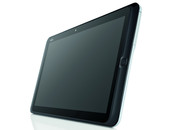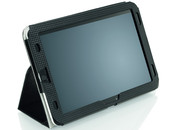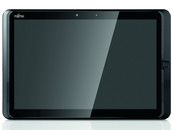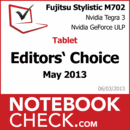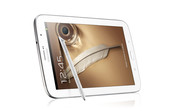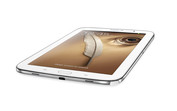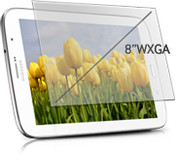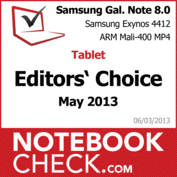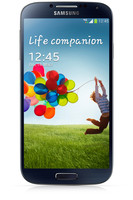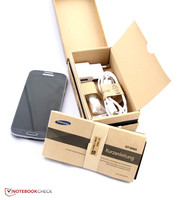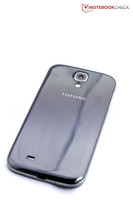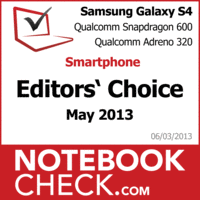Notebookcheck's Best of May 2013 – Smartphones and Tablets
For the original German article, see here.
In April we tested as many as 20 tablets and smartphones. In contrast, May was a relatively sedate month with "only" seven tablets and six smartphones including the first review of a flagship, Samsung's Galaxy S4. That review was especially long and covered all features, advantages and disadvantages of the new top model from the Korean company in detail. Other attractive smartphones under review in May were the entry level models, LG E460 Optimus L5 II and Nokia Lumia 520, the first Windows 8 phone from Huawei called Ascend W1, the Chinese Amoi N828 and the Alcatel One Touch Ultra 997D.
In the tablet segment, Samsung competed with a high end model too, the Galaxy Note 8.0. The other contenders stem from relatively unknown manufacturers or B brands and are mainly mid-range models: the i.onik TP10.1-1500DC-KB with attachable keyboard, the Chinese Ainol Novo 7 Crystal Quad Core, two 7-inch devices, the Bullman Tab 7 Mini UMTS GPS v2 and the Saphir SMT 7-inch 3G+GPS, and the TrekStor Surftab Ventos 10.1. In being a semi-ruggedized tablet, Fujitsu's Stylistic M702 is special.
Tablets
Contenders:
Ainol Novo 7 Crystal Quad Core 79%
Bullman Tab 7 Mini UMTS GPS v2 79%
TrekStor Surftab Ventos 10.1 75%
The i.onik TP10.1-1500DC-KB is a newcomer for notebookcheck.com. The Android tablet PC consists of a tablet and an attachable keyboard dock. The latter comes with a battery. Together with the built-in battery, it manages a long battery life. However, the total weight of tablet and dock is rather high and there are several points of critique regarding build quality. Furthermore, the colors appear pale on the bright, yet low resolution display. In addition, the keyboard dock did not always work satisfactorily. The rather high performance, the material selection and the special Android keyboard are pros.
The Ainol Novo7 Crystal Quad Core is a Chinese device. It comes with a quad-core CPU and an IPS panel for about 90 Euros (~$119). This sounds promising but the manufacturer cannot completely honor this promise. We like the graphics performance, the HDMI-out, which is not even common among significantly more expensive devices, and the low power consumption under load. But, we dislike the modest build quality and the poor camera. Furthermore, it is not really professional that the language is set to Chinese after a reset if you consider that the device is for foreign markets. Further points of critique: no Bluetooth, dark display and low performance despite quad-core SoC.
According to the manufacturer, the Fujitsu Stylistic M702 is semi-ruggedized, that is "partially outdoor ready". Is the 10.1-inch Android device neither one thing nor another? Not at all - as our review shows. Pros include the HD resolution of the display, a big RAM capacity, an extensive scope of delivery, the decent camera, and the fingerprint sensor. Only the high price, the limited brightness of the display and the low benchmark results spoil the good overall impression a little bit. How about the robustness of the tablet? As the manufacturer says: semi...
So far, Bullman could convince with fast 9- and 10-inch tablets for a fair price. But, the Bullman Tab 7 Mini UMTS GPS v2 competes in the currently very popular 7-inch category. The tablet wants to stand out from the competition with two SIM slots and a TV receiver. This sounds nice on paper, but in reality is only nice to some extent. A dual SIM function is interesting for those who use different SIMs for speech and data - e.g. abroad. The speech quality of the Bullman tablet is alright, so it can also be used as a very big smartphone. The TV tuner only supports terrestrial analog signals, which are no longer used in some countries. We wonder why Bullman uses this tuner anyway and why they decided to use a very poor display. The battery life should be longer, too. Even the GPS module with good reception and the fast SoC cannot make up for the flaws.
Note means high performance and pen input at Samsung. This also applies to the Samsung Galaxy Note 8.0, which fills the gap between 5.5- and 10.1-inch Note devices. Like other members of the Note family it scores points with the impressive performance of Samsung's own Exynos processor. In addition, the display is very bright. We would like to see a Full HD resolution and a higher contrast. The battery delivers a longer battery life too. Our critique ends here. The Galaxy Note 8.0 left a very positive impression and is one of the best tablets available - even more so among 7- and 8-inchers.
With the Surftab Ventos 10.1, the German manufacturer TrekStor enters the 10-inch segment. In our view, it was an unsuccessful attempt. High-end materials are used and the build quality is alright, but the contrast-rich display is very dark and the touchscreen imprecise. In addition, frequent stuttering spoils the usage experience. Furthermore, cameras and speaker are poor and the Wi-Fi module has an extremely limited range. In the end, we finally had to decrease the rating of the tablet because of these flaws.
The name Saphir SMT 7-inch 3G+GPS already describes what it includes in detail. It is a 7-inch tablet with 3G module and GPS receiver. However, the 3G module is not the most modern and fastest of its kind. The GPS sensor does not work exemplarily either. So, the tablet cannot replace a fully fledged satellite navigator. But, there are also pros: many accessories, HDMI, wide viewing angles, and a decent performance. The dark, partly flickering display and the modest build quality prevent a better rating.
Tablet of May 2013: Fujitsu Stylistic M702 and Samsung Galaxy Note 8.0
After two months with x86 tablets as winners, two ARM based tablets with Android win the first prize again. Despite a completely different design, the Fujitsu Stylistic M702 and the Samsung Galaxy Note 8.0 achieve exactly the same rating.
What we like
Fujitsu has included more or less every interface with the tablet, as well as an ample amount of RAM and an SoC that works satisfactorily.
What we'd like to see
For outdoor use the display is too dark, the glass surface of the display is too reflective, and the contrast is too low - when taking the semi-ruggedized tablet outdoors it is difficult to see anything on the display.
What surprises us
The extensive range of connectivity options and the elaborate assortment of accessories were very much to our liking. In addition to this the battery life is quite good, and a water and dust proof case could also be a big advantage.
The competition
What we like
The tabphone feels good to the touch and lies comfortably in the hand. The price of around 460 Euros (~$613) seems justified - especially since Galaxy Notes are usually a lot more expensive right after launch.
What we'd like to see
Better contrast and a lower black value. It would also be nice if the battery would last another hour or more.
What surprises us
The display is extremely bright and the performance speaks for itself. The Exynos Quad-Core 4412 easily outperforms the competition.
The competition
Bullman Tab 9 AQQ Revolution
Easypix SmartPad EP800 Ultra
Smartphones
Contenders:
Huawei Ascend W1 86%
Alcatel One Touch Ultra 997D 84%
Samsung Galaxy S4 GT-I9505 90%
Amoi N828 84%
Nokia Lumia 520 86%
Huawei pushed into the international smartphone market in recent months. Therefore, it was only a matter of time until the Chinese company launched its first Windows 8 phone. Early in May, it finally released the Huawei Ascend W1. The hardware is not surprising for a Windows 8 device, but the cheap recommended price of 219 Euros (~$292) is, even more so because it is traded for below 200 Euros (~$266). The Huawei comes with a bright and contrast-rich IPS panel with modest resolution, an appealing build quality and more than sufficient performance. However, RAM and internal storage are small. Fortunately, the latter can be enhanced with a microSD card. As several apps refuse to run because of the small RAM, the W1 cannot be fully recommended.
"Alcatel are French" could be a comment to our review. So, why do we call the Alcatel One Touch Ultra 997D a Chinese phone? Because smartphones from Alcatel are actually produced by a Chinese manufacturer and so is our test sample, which is available for 249 Euros (~$332). In contrast to the Huawei Ascend, you will immediately find that the Alcatel phone is indeed an entry level device. The materials appear cheap and plain plastic dominates the case. Android version 4.0 was already outdated at the time of testing. Battery life and graphics performance could also not convince. The display and the decent build quality are pros. To summarize, the Alcatel still performed decently.
Such a verdict would be a shame for the new top model from Samsung, the Galaxy S4. After all, its predecessor the S3 was the world's most successful Android phone. So, the new flagship of the Korean company has big shoes to fill. Our review proves that the S4 can even perform better. Samsung uses extremely powerful hardware, although we miss the hyped Octa 5 processor from their own production line. In addition, the S4 is only available with 16 GB memory – which is typical for the smartphones from this large corporation. Of course, Samsung uses a plastic case with respective advantages and disadvantages again. The haptics are not as good as an aluminum-unibody's, but the Samsung comes with a microSD slot - and even more important - a removable battery. The list of pros is very long and includes the very high performance and superb Full HD display with super AMOLED technology. Pictures from the main camera are impressive for a smartphone. The new contactless control options are interesting, but not yet mature. In the end, the S4 achieves one of the best ratings so far. But, it is too low for first place in our Smartphone Top 10.
The Amoi N828 is another typical Chinese smartphone. It delivers a quad-core processor, 1 GB RAM, and an IPS panel with a decent resolution for 180 Euros (~$240). This is usually difficult or impossible to find. Nevertheless, the Amoi N828 is not a cheap low-end model. It convinces with a solid build quality, decent performance, and a bright display with wide viewing angles. The speaker works decently too. However, at a closer look you will notice the origin and the savings measures. You cannot install apps on the internal memory and after a reset the phone speaks Chinese and most users won't understand a word. Nevertheless, the Amoi N828 is a good smartphone, but won't often be seen in school as it does not have a good image.
Nokia currently launches one smartphone after the other. The Lumia 520 is already the fourth model in the Lumia series. It is a budget model with a recommended price of a cheap 199 Euros (~$265). Nevertheless the hardware is still uncompromising and nearly identical in all Lumia models. A 4-inch display is rather big for this price, but the low resolution is usual in this class. The Nokia Lumia 520 scores points especially with its bright IPS display, the long battery life and the decent build quality. Furthermore, we liked the expandability via microSD card, which is common place in Nokia phones. Outdoors, it is not very easy to read from the screen and the image quality of the camera should be improved.
Apart from Samsung, LG is the second big competitor from South Korea. In May, LG introduced three new models of the Optimus L series: L3 II, L5 II, and the L7 II. We already reviewed one of them, the LG E460 Optimus L5 II. It is a mid-range device of the new family and comes with a 4-inch display with modest resolution. The cheap Android smartphone has a recommended price of 189 Euros (~252) and shone with a bright display with wide viewing angles in our review. Its graphics performance was convincing too. Furthermore, the device is comfortably light. With NFC and HSUPA it supports modern standards. We especially liked the speech quality. The small memory, the low contrast, and the weak camera are cons.
Smartphone of May 2013: Samsung Galaxy S4 GT-I9505
Eagerly awaited, the Samsung Galaxy S4 can meet nearly all user demands. In May, the new top model from South Korea easily won the competition.
What we like
The Samsung Galaxy S4 manages to live up to its great legacy: Display, performance, haptics, camera, software and handling are top-notch.
What we'd like to see
The Galaxy S4 marks a successful evolutionary step in the development of the series, but it arrives without any groundbreaking innovations.
What surprises us
That Samsung chooses to include annoying bloatware, even in its flagship device.
The competition
Samsung Galaxy S III, Samsung ATIV S, Apple iPhone 5, HTC One, HTC One X+, LG Optimus G, Google Nexus 4, Nokia Lumia 920, HTC 8X, Sony Xperia Z, Sony Xperia ZL, Blackberry Z10.




